Research Article - (2017) Volume 7, Issue 5
Adegoke AG, Salami AT and Olaleye SB*
Department of Physiology, Faculty of Basic Medical Science, College of Medicine, University of Ibadan, Ibadan, Nigeria
Corresponding Author:
Olaleye SB
Department of Physiology, Faculty of Basic Medical Science
College of Medicine, University of Ibadan, Ibadan, Nigeria
Tel: +91979714977
E-mail: sbolaleye@yahoo.com
Received date: August 31, 2017; Accepted date: September 29, 2017; Published date: October 09, 2017
Citation: Adegoke AG, Salami AT, Olaleye SB (2017) Cadmium Exacerbates Acetic Acid Induced Experimental Colitis in Rats. Eur Exp Biol. Vol. 7 No. 5:27. doi: 10.21767/2248-9215.100027
Copyright: © 2017 Adegoke AG, et al. This is an open-access article distributed under the terms of the Creative Commons Attribution License, which permits unrestricted use, distribution, and reproduction in any medium, provided the original author and source are credited.
Background: Increase in the incidences of inflammatory bowel disease (IBD) in developing countries is a pointer to the role metal toxicants may play in its pathogenesis. Cadmium (Cd) has been implicated in the etiology of diseases involving several tissues including the colonic mucosa. This present study aimed at investigating the effects of oral cadmium exposures on healing of acetic acid (AA)-induced colitis in rats.
Methods and Findings: Male Wistar rats (100-120 g) were grouped and exposed to cadmium as follows: Control (water), Cd25 (25 ppm CdCl2), Cd50 (50 ppm CdCl2), Cd100 (100 ppm CdCl2) for four weeks. Colitis was induced by intrarectal administration of 2 ml 4% acetic acid. Rats were sacrificed and colons were resected on days 0, 3, 7 and 14 of colitis induction. Weekly body weight, diarrheal and macroscopic scores, organ weights, neutrophil/lymphocyte ratio (NLR), malondialdehyde (MDA) concentration, and regeneration in colonic tissues were studied microscopically.
Cadmium significantly (p<0.05) decreased weight gain (%) at weeks 3 and 4 in Cd100 group, significantly (p<0.05) increased stool consistency scores on day 5 in Cd100 group, increased colon macroscopic scores in Cd100 group on days 3 and 7, significantly (p<0.05) increased neutrophil/ lymphocyte ratio on days 0 and 7 in Cd50 and Cd100, and colonic MDA concentrations in each of Cd25, Cd50 and Cd100 from day 3 till day 14. Colon histopathology persisted till day 14 in Cd100 group.
Conclusions: These data indicate that cadmium delayed healing of acetic acid induced colitis and inflammatory pathways may be implicated.
Keywords
Colitis; Cadmium chloride; Malondialdehyde
Introduction
Inflammatory bowel diseases are chronic diseases of the bowel which includes Crohn’s disease and ulcerative colitis. It rises from uncontrolled intestinal inflammation resulting from deranged immune responses [1]. Genetic IBD research has been helpful in identifying a number of genes that are prone to this disease however, none of them alone is sufficient enough to initiate the disease [2,3]. Environmental factors which includes smoking, appendectomy and childhood exposures to antibiotic may be involved in the pathogenesis of IBD [4,5] non-other however, apart from these factors have been identified in the pathogenesis of IBD [6-9].
The continuous increase in the incidences of IBD in industrially developing countries including Nigeria, is a pointer to the potential role of industrialization and its resultant environmental pollutants [10-13] in the pathophysiology of IBD [14,15]. Industrialization has led to an increase in the accumulation of heavy metals in our surrounding ecosystems; one of such metals is cadmium, found in the environment [16].
Cadmium is an element of the group IIb in the periodic table; air, water, food and smoking represent significant sources of cadmium [17], and it has a high rate of soil to plant transference [18]. Several studies have reported the side effects of cadmium exposure on health; erosion of the gastric mucosa, lower gastrointestinal irritation and erosion, vomiting, abdominal pain and diarrhea as well as nervous and cardiovascular disorders after exposure to high levels in experimental and clinical conditions [19-22].
In spite of the known toxic effects of cadmium, its effect on colonic intestinal inflammation is not known; particularly in the pathophysiology of ulcerative colitis. The aim of this study was to investigate the effect(s) of oral cadmium exposure on the healing of experimental colitis in rats.
Materials and Methods
Chemicals and reagents
Cadmium Chloride salts (CdCl2) (Burgoyne Burbidges & Co Mumbai-India), ketamine (Rottexmedica, Germany) and acetic acid (BDH, London).
Animals
Male Wistar rats (100-120 g) obtained from the University animal house and were acclimatized for two weeks prior to commencement of experiment, contained in wire-meshed cages, kept under standard conditions with food (vital feed; crude protein 14%, fat 7%, crude fibre 10%, calcium 1.0%, phosphorous 0.35%) and water made accessible to them freely. The Experimental protocol was approved by the Gastrointestinal Research Group, University of Ibadan. Handling of the animals was in line with international guidelines on the care and use of laboratory animals in research [23].
Experimental design
Animals were randomly assigned into four groups of twenty rats each; Control group was given drinking water, three other groups received cadmium chloride (CdCl2) at 25 ppm, 50 ppm and 100 ppm respectively in drinking water. Colitis was induced in all the groups after four weeks and rats were monitored two weeks post colitis induction; they were sacrificed at predetermined intervals of days 0,3,7 and 14 of colitis and whole colon was resected macroscopic scoring and histology. Weekly weight of rats in all the groups were taken weekly throughout the experiment and blood cadmium levels were assayed after four weeks of exposure.
Induction of colitis
Colitis was induced after cadmium had been appropriately administered for four weeks; a modified method of colitis induction previously described by [24,25] was followed – rats were fasted for 24 hours but were given access to water ad libitum and were thereafter, anaesthetized with 35 mg/kg intraperitoneal ketamine, then an improvised Teflon cannula was inserted intrarectally into the colon 8 cm proximal to the anus of the animals to induce colitis by administering 2 ml of 4% acetic acid, this was retained for 55 seconds, after which it was withdrawn. The rats were thereafter monitored and scored for the presence of diarrhea [26], at predetermined intervals.
Stool consistency scoring
Stool consistency was monitored and scored daily according to the method of [26], with slight modifications as follows: 0- (normal), 1-(soft but still formed), 2-(very soft), 3-(diarrhea).
Collection of blood and tissue samples
Blood samples were obtained from each animal prior to euthanasia, through the retro orbitals plexus using capillary tubes. Animals were thereafter euthanized and colon, kidney, liver and spleen were removed from each animal for organ weights, macroscopic scoring and histopathological analysis as applicable. Colon samples for histopathological analysis were immediately fixed in 10% buffered formalin.
Macroscopic scoring
The macroscopic appearances were scored using a scale of 0-4 as follows:
0=no damage; 1=hyperemia, no ulcers; 2=linear ulcer with no significant inflammation; 3=linear ulcer with inflammation at one site; 4=two or more sites of ulceration/inflammation; 5=two or more major sites or of ulceration and inflammation or one site of ulceration/inflammation extending>1cm along the length of the colon; 6-10=If damage covers>2 cm along the length of the colon, the score is increased by one from each additional centimeter of involvement [27].
Determination of blood cadmium concentration
Blood (1 ml) was digested with HNO3 (2 ml in each) as previously described by [28,29]. Cadmium concentrations were assessed from the filtrates using an atomic absorption spectrophotometer and its concentration was measured in parts per million (ppm).
Other procedures
Malondialdehyde concentration was determined by the method of [30], differential white cell counts by the method described by [31] and histological studies were performed by a slight modification of the method previously described by [32].
Statistical Analysis
Analysis of data was performed using a statistical softwaregraph pad prism (version 5.0). Results were expressed as Mean ± standard error of mean (S.E.M), statistical significance was assessed using one-way analysis of variance (ANOVA). Differences were considered significant at *p<0.05.
Results
Effect of cadmium on body weight after four weeks of exposure
There were significant decreases in weekly percentage weight gain (%) (Figure 1) by weeks 3 and 4 (128.07 ± 3.40 and 123.57 ± 3.34) in Cd100 group when compared with control (141.75 ± 4.75 and 139.65 ± 4.51).
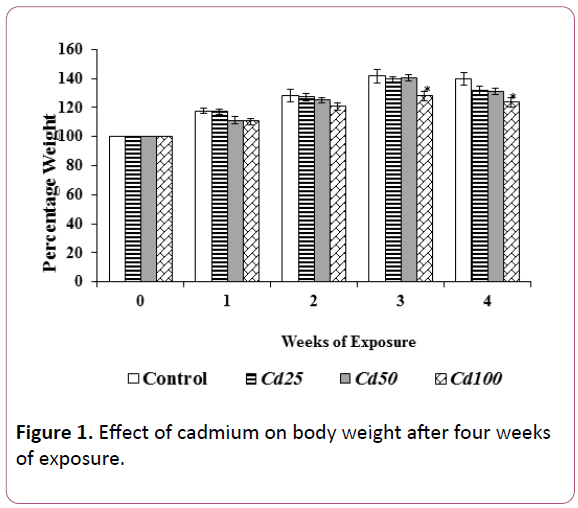
Figure 1. Effect of cadmium on body weight after four weeks of exposure.
Each bar is expressed as mean ± S.E.M of 5 rats. Where Cd25=Cadmium at 25 ppm; Cd50=Cadmium at 50 ppm and Cd100=Cadmium at 100 ppm. *=p<0.05 values differ significantly from control group.
Blood cadmium concentration analyzed by atomic absorption spectrophotometer
Blood cadmium concentration (ppm) (Figure 2) was significantly high in Cd50 (0.04 ± 0.00) and Cd100 group (0.04 ± 0.00) when compared with control (0.03 ± 0.00) by the end of four weeks’ cadmium exposure.
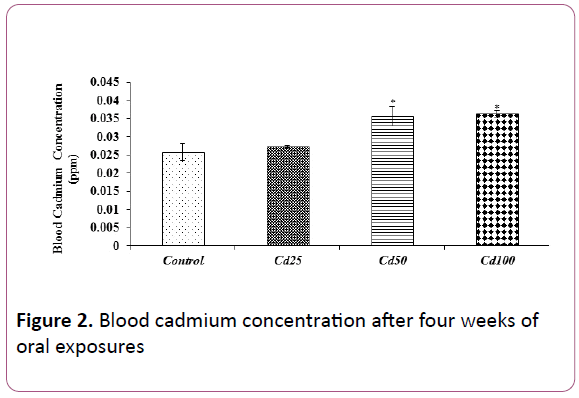
Figure 2: Blood cadmium concentration after four weeks of oral exposures
Each bar is expressed as mean ± S.E.M of 5 rats. Where Cd25=Cadmium at 25 ppm; Cd50=Cadmium at 50 ppm and Cd100=Cadmium at 100 ppm. *=p<0.05 values differ significantly from control group.
Effect of cadmium on kidney weight
There were significant increases in the kidney weight (g) in Cd100 group (0.48 ± 0.02) when compared with control group (0.40 ± 0.01) by day 7 (Figure 3).
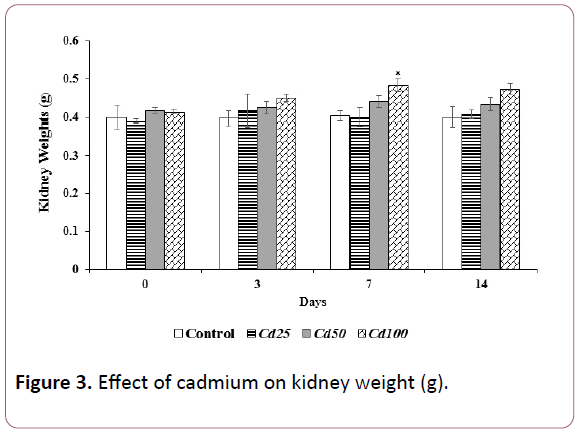
Figure 3: Effect of cadmium on kidney weight (g).
Each value is expressed as mean ± S.E.M of 5 rats. Where Cd25=Cadmium at 25 ppm; Cd50=Cadmium at 50 ppm and Cd100=Cadmium at 100 ppm. *=p<0.05 values differ significantly from control group.
Effect of cadmium on stool consistency post colitis induction
There were significant increases in stool consistency (Figure 4) by day 5 in Cd100 group (2.5 ± 0.22) when compared with control (1.5 ± 0.22).
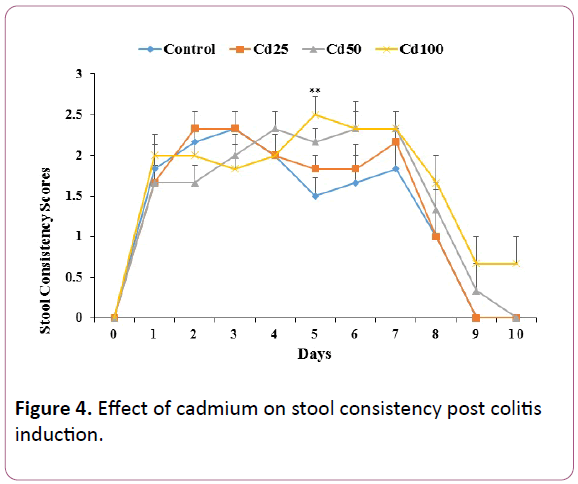
Figure 4: Effect of cadmium on stool consistency post colitis induction.
Each value is expressed as mean ± S.E.M of 5 rats. Where Cd25=Cadmium at 25 ppm; Cd50=Cadmium at 50 ppm and Cd100=Cadmium at 100 ppm. *=p<0.05 values differ significantly from control group.
Effect of cadmium on colon macroscopic scores
Macroscopic scores from the Cd50 and Cd100 by days 0, 3, 7 and 14 were increased when compared with control (Figure 5), this was however not statistically significant.
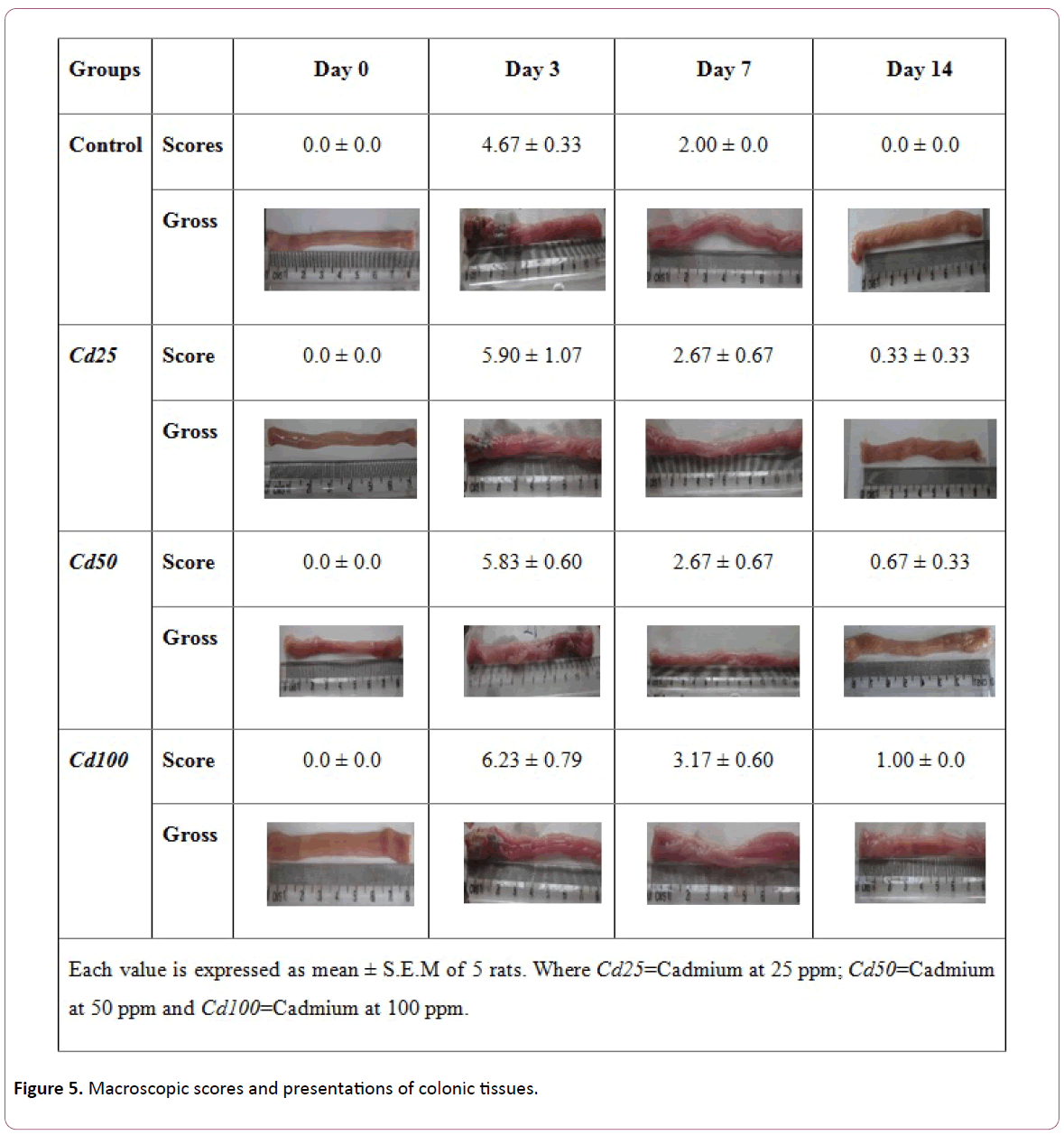
Figure 5: Macroscopic scores and presentations of colonic tissues.
Effect of cadmium on neutrophil/lymphocyte ratio
Neutrophil/Lymphocyte ratio (Figure 6), was significantly increased in Cd50 (0.43 ± 0.04; 0.80 ± 0.06) and Cd100 (0.49 ± 0.03; 0.80 ± 0.03) when compared with control (0.36 ± 0.03; 0.63 ± 0.04) on day 0 and 7, respectively.
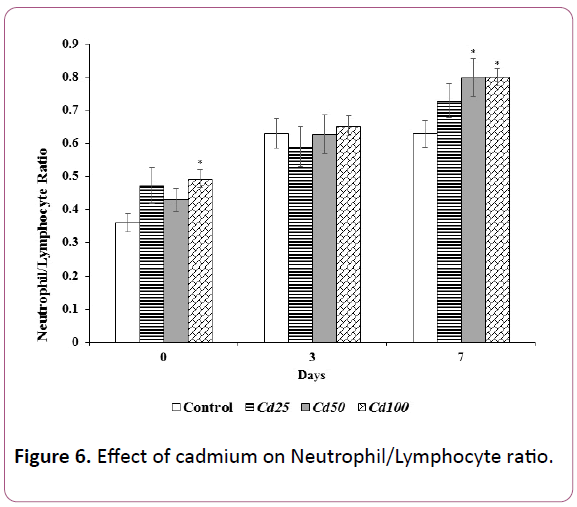
Figure 6: Effect of cadmium on Neutrophil/Lymphocyte ratio.
Effect of cadmium on malondialdehyde concentration
Significant increases in the concentration of malondialdehyde (nmol mg/protein) were seen (Figure 7) at day 7 in Cd25, Cd50 and Cd100 groups (0.56 ± 0.02; 0.61 ± 0.03; 0.65 ± 0.01) and at day 14 (0.41 ± 0.02; 0.52 ± 0.02; 0.60 ± 0.02) when compared with control (0.50 ± 0.02; 0.31 ± 0.00) at days 7 and 14, respectively.
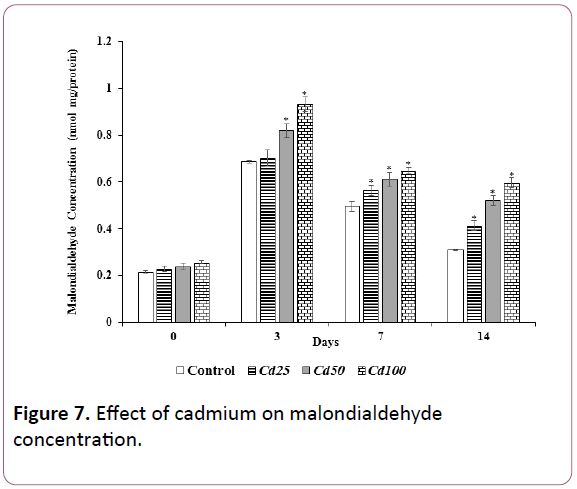
Figure 7: Effect of cadmium on malondialdehyde concentration.
Each bar is expressed as mean ± S.E.M of 5 rats. Where Cd25=Cadmium at 25 ppm; Cd50=Cadmium at 50 ppm and Cd100=Cadmium at 100 ppm. *=p<0.05 values differ significantly from control group.
Each bar is expressed as mean ± S.E.M of 5 rats. Where Cd25=Cadmium at 25 ppm; Cd50=Cadmium at 50 ppm and Cd100=Cadmium at 100 ppm. *=p<0.05 values differ significantly from control group.
Effect of cadmium on colonic histology
Lymphocyte infiltration of different levels in the mucosa, edema, erosion, ulcer and regenerating crypts are seen in Cd25, Cd50 and Cd100 groups when compared with control (Figure 8).
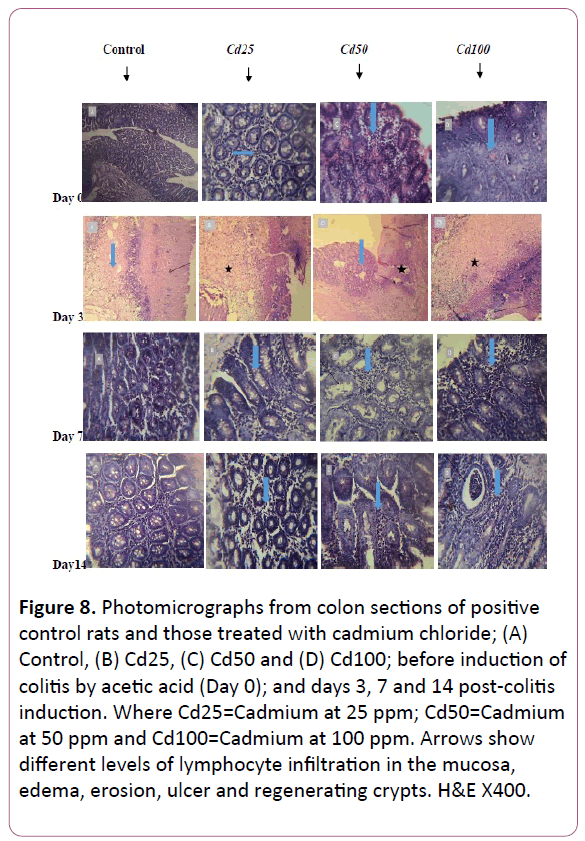
Figure 8: Photomicrographs from colon sections of positive control rats and those treated with cadmium chloride; (A) Control, (B) Cd25, (C) Cd50 and (D) Cd100; before induction of colitis by acetic acid (Day 0); and days 3, 7 and 14 post-colitis induction. Where Cd25=Cadmium at 25 ppm; Cd50=Cadmium at 50 ppm and Cd100=Cadmium at 100 ppm. Arrows show different levels of lymphocyte infiltration in the mucosa, edema, erosion, ulcer and regenerating crypts. H&E X400.
Discussion
In the present study, intrarectal administration of AA caused an increase in stool consistency scores; this was more pronounced in cadmium at 100 ppm group by day 5 post colitis induction. It may be due to inflammation reactions within the colonic mucosa caused by AA in addition to the already accumulating effect from cadmium. However, AA has been documented to induce localized inflammation, desquamation and loss of mucosal integrity leading to epithelial injury [33].
Cadmium decreased weekly percentage weight gain; this finding is consistent with previous reports by [34-37]; they reported that Sprague-Dawley rats that received cadmium by gavage exhibited decreased body weight. These decreases in body weight gain may be due to increased degeneration of lipids and proteins [38], decreased growth rate or decreases in nutrient digestion and absorption [39,40]. Decreased body weight and decreased growth rate have however, been common findings in studies where experimental animals are orally exposed to cadmium [41,42].
The increase in kidney weight observed in this study could be due to cadmium effects. [41,43] had earlier reported kidney swelling after subcutaneous and oral exposures of cadmium in rats.
Increased blood cadmium concentration of the cadmium at 50 ppm and cadmium at 100 ppm groups after four weeks indicates sufficient exposure [44]. Although the concentrations were generally low, reports have shown that exposures to high cadmium concentration orally or intravenously still presents as extremely low in the blood [45].
Neutrophil/Lymphocyte ratio (NLR) is an index that can be used to measure disease progression particularly during inflammation [46]. The observed increase in Neutrophil/ Lymphocyte ratio in cadmium at 50 ppm and cadmium at 100 ppm on days 0 and 7 may be indicative of continuous activation of inflammatory cells by cadmium.
Macroscopic scores are useful in assessing gross lesions or alterations during tissue injury, the increase in these scores may be indicative of ulcers and edematous formations; [47] and [48] had earlier reported such observations.
Earlier researches have documented MDA as one of the products of lipid peroxides and it marks for peroxidation in cells [49]. The notable increase in MDA concentration in cadmium at 50 ppm and cadmium at 100 ppm groups by day 3 may be indicating oxidative stress which is common during cadmium exposures [50-53], while cadmium at 25 ppm group on the same day had MDA values not different from that of control; it may be that cadmium at 25 ppm was not sufficient enough to increase oxidative stress or that endogenous antioxidant enzymes and molecules were stimulated by cadmium and they were able to maintain biochemical homeostasis.
An adaptive response to cadmium by cells may also, have been induced thereby causing resistance to MDA, Hart and colleagues [54-56] found out that repeated exposures to cadmium at low concentrations to alveolar epithelia cells can result in the development of an adaptive survival response. However, increases in MDA seen in cadmium at 25 ppm, cadmium at 50 ppm and cadmium at 100 ppm groups on days 7 and 14 may be as a result of stimulated endogenous enzymes that have been exhausted from cadmium-stimulated reactions.
Histological evaluation showed that cadmium caused erosion of colonic epithelium, increased severity of colonic injury, and delayed healing in cadmium at 50 ppm and cadmium at 100 ppm groups up-till day14 of colitis, this may be indicative of a continuous stimulation of colonic inflammatory cells due to a sustained exposure to cadmium. [57] and [58] reported a similar finding, where oral administration of cadmium compounds caused desquamation of the colonic epithelium.
Conclusion
It can therefore be concluded, that cadmium increased colonic inflammation in rats during colitis through increased neutrophil/lymphocyte ratio and lipid peroxidation thereby delaying healing of acetic acid induced colitis.